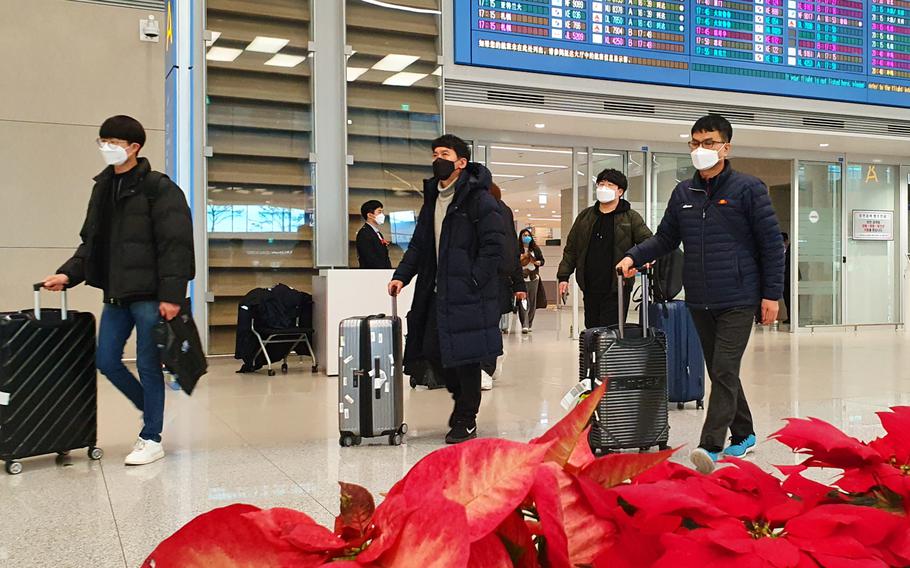
Airplane passengers exit an arrival gate wearing masks over worries of contracting the spreading Coronavirus at Incheon International Airport, South Korea, Monday, Feb. 3, 2020. (Matthew Keeler/Stars and Stripes)
Air travelers need to do more than just remember to bring a mask — they need to bring the right kind.
A handful of airlines, mostly in Europe, have banned cloth face coverings in favor of higher-standard versions including surgical masks or respirators. Last month, Finnair joined a list that includes Air France, Lufthansa, Swiss International Air Lines and Croatia Airlines.
"The health and safety of our customers and crew is our first priority, and fabric masks are slightly less efficient at protecting people from infection than surgical masks," Finnair spokeswoman Heidi Lemmetyinen said in an email. The airline allows surgical masks and filtering respirators such as FFP2 or FFP3, as well as others that are equivalent to the N95 standard.
While U.S. airlines do have some restrictions on masks — none with valves are allowed, for example — they do not prohibit travelers from wearing cloth or fabric versions. The federal mask mandate for planes, trains and buses has been extended until mid-January.
"Some studies show a modest improvement of efficacy of surgical masks compared with cloth masks," said Perry Flint, a spokesman for the International Air Transport Association. "But any face covering has shown to significantly reduce spread of aerosols, and at this point we have not taken a position on what types of face masks should be required."
Experts say it's a smart idea for more airlines to get specific about the types of face coverings they allow and to only allow those that meet high standards.
"It is very important because different masks have different filtration capabilities," said Purvi Parikh, an immunologist at NYU Langone Health, in an email. "A plane is a place that is indoors and many people in a close space and very difficult to social distance — so masks can make a big difference especially with the delta variant."
Parikh said she has seen people wear bandannas or neck gaiters on planes, which are not highly protective. She prefers double-masking with a surgical mask or using an N95 or KN95.
"At least with medical grade masks there is a uniform standard even if you do not double mask like I chose to," she said in an email. "Compliance is key as well and airlines should have a no tolerance policy to remove people from planes and/or punish in accordance with federal laws."
The Transportation Security Administration says a mask can be homemade or manufactured, and it "should be a solid piece of material without slits, exhalation valves, or punctures." The Centers for Disease Control and Prevention's guidance says coverings should have two or more layers of washable, breathable fabric; completely cover the nose and mouth; fit snugly against the side of the face without gaps; and include a nose wire to keep air from leaking out the top.
U.S.-based carriers are not putting the stricter requirements in place that airlines in other parts of the world have.
Most airlines that replied to the Washington Post's questions provided their own policies and did not comment on whether they would follow the example of the European carriers that have forbidden cloth masks. Delta Air Lines spokesman Morgan Durrant said there are no changes planned for the airline's mask rules at this point.
Delta, like other carries, does not allow any mask with an exhaust valve or opening. The airline also prohibits bandannas, scarves, ski masks and balaclavas. Gaiters with two layers are permitted, and Delta says cloth masks should be made with tightly woven fabric, preferably two- or three-ply.
American Airlines says gaiters, balaclavas, bandannas, masks made of mesh or lace, scarves and ski masks are not allowed. It specifies that a face covering must be a mask or two-layered, secured cloth that completely covers the nose and mouth and fits snugly under the chin and to the sides of the face.
Southwest says that masks made from a single layer or thin fabric that does not block light are not acceptable. Also not allowed: anything with slits or valves, bandannas, scarves, ski masks, balaclavas, the collars of shirts or sweaters, or masks that don't fit properly.
United also does not allow bandannas, but it lays out fewer restrictions than competitors.
Richard Flagan, a professor of chemical engineering and environmental science and engineering at the California Institute of Technology, has tested multiple kinds of masks during the pandemic. He said he would like to see airlines require at least KN95 masks for everyone.
"If you're in a closed environment, you're forced to sit next to people without any kind of social distancing," he said. "They should be requiring everyone to wear masks to protect not just themselves, but the people around them."